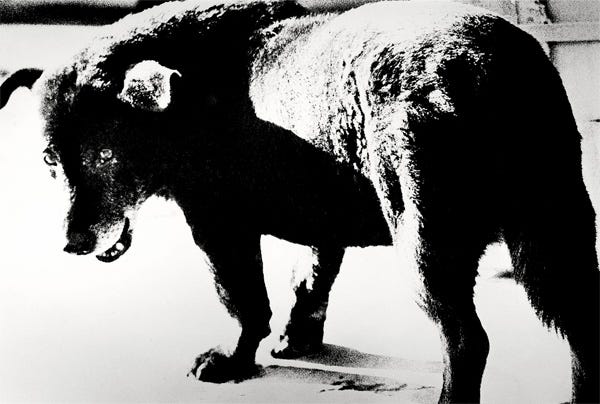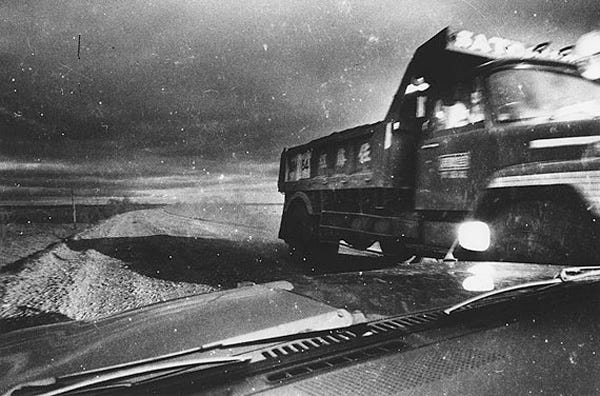Under the Magic of Moriyama Daido
About how Moriyama Daido became one of the mental teachers for me and stimulated me to go to Japan

In 2010, when I was just beginning to comprehend the basics of film photography and chasing “decisive moments”, my eyes fell on the Japanese photographer Moriyama Daido. What can I say? His personality inside Japan is a cult. In the West, it causes a dual impression. His style and presentation of the material are so different from the generally accepted that people either hate Moriyama, accusing him of banality and lack of taste, or adore him for his manner of presenting the material. In the US, he even got the nickname of the “godfather” of street photography.

I was very stuck then. For a very long time I could not understand what was attracting me to his photographs, why are they so radically different from Bresson, Frank, Vinogrand? How to solve his code? I fought over the answers for more than one year. As a result, one book from the author, entitled World Through My Eyes, turned into a whole collection of photo books from different eras and times. And if you ever ask me who was my photography teacher (mental), then I will honestly tell you that Moriyama Daido played a key role. Already a lot of soul strings crossed with his wave. This text is a tribute to the creativity of the master and the desire to move away from.

Moriyama rebel
In 1961, Moriyama moved to Tokyo, where in 1964 he met with Nakahira Takuma. In 1968, the famous Provoke magazine was published, to which Moriyama also joined in the second issue. The magazine lasted 4 issues, after which the team broke up, and the release of new issues ceased. At the time of publication, the publication did not receive due attention from the public, but became the starting point for the new language in photography. Language brought to absurdity, extremes: are-bure-boke (あ れ ぶ れ ー 暈 け), which is translated from Japanese as “camera shake, out of focus”. It was precisely the pronounced grain in the photographs, the lack of focus and the heavy gradations of gray that became Moriyama's hallmark. In 1972, this style took on a peak in Farewell Photography (Shashin no Saionara). Subsequently, unable to withstand the emotional tension, he became addicted to drugs and actually fell out of the world of photography for many years. But nevertheless, thanks to close friends and photography, which he could not eventually abandon, the world did not lose him.

I plan to turn to the style of Provoke magazine in the future, since the ideas of the magazine were much broader and more interesting. In the meantime, we will return back to the author. Moriyama is one of those few who must first be understood to love. I like Japan and read about Japan. On the one hand, I watch the NHK channel, and on the other, black and white and not the cleanest side of Japan from Daido. So I have a more complete picture of this interesting country. When projecting photographs of Moriyama onto Russian reality, I retroactively sense the points of contact between cultures, mentality and the equally great difference between peoples and nations. It is interesting. Best of all, it is precisely as a source of everyday life that the author is revealed in his periodical journal Record. The magazine is a stream of consciousness from a pure photograph supported by a small portion of the author’s text. This is not a project with a strong philosophical base and as simple as it could be. This is life through the prism of the author and some of his impressions on life. Moreover, the pictures often depict the simplest things, but in order to shoot simple things you have to be a brave and intelligent person.

Sophisticated man, simple cameras.
I don’t know any other person who would treat cameras so simply. Moriyama Daido has always preferred simple and affordable cameras. Often these were point-n-shoot cameras, small one or half-frame devices. Sometimes, in the old press, he took pictures with a SLR Pentax and even with a 6x6 TLR Minolta, however, he was remembered for using Ricoh GR series camera. He recently preferred simple cameras from Nikon, but was later spotted with Sony cameras and again with a series of GR from Ricoh. Every time whenI hear about RAW, about megapixels, about blowout lights I remember Moriyama and his attitude to photography tools, as well as about his merits in the world of photography. This is a good reason to stop experiencing complexes about your own technology and start just taking photos.

Simple cameras, simple eye.
Daido has a similar attitude to photography. Simple cameras set up a simple relationship with life. If something works for a photograph, that’s good. If something catches his eye - it is worthy to be photographed. The rest is not so important. The documentary Near Equal very well reveals what I described above. On the street he is like a dog that every day goes around its territory and leaves “marks”. And it is not without reason that his most canonical photograph is a photograph of a stray dog made by him completely by accident. Over many years of being on the same streets, many photographers begin to blur their eyes and lose not only the feeling of the novelty of the place, but also the passion for cognition. When you take things simpler, it’s easier to keep this childish curiosity in yourself. When you associate yourself with an animal, it is easier to act instinctively.
Moriyama Daido in his work went through many obstacles and remained faithful to photography. In 2020, the godfather of street photography will turn 82 years old and he still walks with the camera at the ready. Like a little child who never got bored of the street. He still produces books and he is still faithful to his pronounced style, although he has been experimenting with color a lot lately. I would very much like to keep in my soul a passion and surprise for both life and photography.

He especially loves monochrome images. According to Daido himself, to see the world in black and white is how to see the world without clothes. Monochrome is characterized by symbolism, abstraction and eroticism. The older I get in my own work, the more clearly I see this thin line between the color and monochrome world. That is why when I pick up a digital camera and see a color image on the screen, I do not see it in monochrome. On the other hand, when I have a black and white film in my camera and I don’t see a color image, my style and look seem to be cleared and try not to notice the color, ignore it. In 2016, I had to shoot a lot exclusively on digital cameras and I’m almost used to the fact that digital photography is a color photograph.
Since I wrote this article 3 years ago, and upload it to my blog now, I want to add something. Since 2017, I began to shoot on film less and less. Right now I completely switch to digital cameras and began to shoot exclusively in color.

Daido Moriyama and his self-portrait.
The most important conclusion that I made for myself thanks to Daido is that we photograph not so much the world around us as we look into the depths of our own souls. Into our inner world. With all ours fears, complexes and experiences. It is visible in our photographs and is well transmitted. When you walk the street for many years and peer into the city, the city begins to peer at you. At one time I was running after the “events” on the street, but now I am more focused on what I like. At the same time, Daido Moriyama and Japanese photography as a whole are strong in that the author's ego is almost not noticeable on it. What does this mean? A photograph at the moment a button is pressed is a reflection of its author, but when it meets the viewer, it can be read in a completely different way from the author’s intention. This engagement is key to enriching photography itself. However, the stronger the author’s ego in the photograph, the more difficult it is to engage the viewer in this game. Therefore, I do not really like modern project photography, where the idea overshadows the visual range, making the overall impression straight and boring.

As a result.
The more I became acquainted with Moriyama’s work, the better I realized that he was more interested in life itself than in photography. At the same time, he cannot imagine himself without photography and travel. The absence of a heavy philosophy, vivid images, a simple look and ease in life are all what I love this author for. Of course, he is not the brightest photographer in the world, but his vivid experience and monochrome world deserve attentions.


